Reprinted with permission from Custom Woodworking Business.
A look at some of the ways this versatile finish can be used
By Mac Simmons
This article came about while I was organizing a layout for a special color glazing workshop for the prestigious Long Island Woodworking Club. While writing an outline for the presentation, I started thinking about the versatility of color glazing in the art of finishing. Glazing has numerous applications in both fine furniture finishing and fancy faux finishes. This article contains information about some of the applications for colored glazes.
Glazing on sealed natural woods
This glazing technique can be applied whenever you are finishing woods that have a tendency to blotch. It also adds color to the clear finish while retaining excellent clarity, and it can be used to add color to open-grained woods; it only adds color to the pores without filling up the wood's grains.
To prevent blotching or to add color to your wood, first apply either a sealer or a clear coat that you normally use to seal off the wood. Then allow an appropriate amount of time for the coating to dry.
NOTE: The sealer or clear coats serve three purposes in glazing: They seal the wood; they prevent the wood's features or any of the background colors from changing when colored glazes are applied; and if you make a mistake or are not satisfied with the results of the colored glaze application, the sealer allows you to simply wash off the colored glaze with mineral spirits and try again.
After the sealer or clear coat is applied, wipe on your glaze of choice and begin brushing it back and forth across the work. Continue brushing until the glaze is completely brushed out and has disappeared. You should then allow the glaze to dry completely and seal or clear coat over it. You can repeat this process until you achieve the color you want.
This "brushing out" technique is an excellent method of adding and blending color while retaining excellent clarity for your finish. It also is useful for refinishing and many kinds of restoration work. (See Photo Group A for an example of a brushed-out glaze over sealed raw clear wood.)
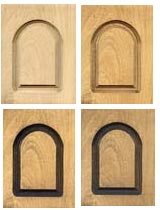
To add color to open-grained woods, apply a sealer or your regular clear coat, wipe a dark-colored glaze into the pores of the woods and allow it to dry thoroughly. Sand off the dry glaze (however, do not be too aggressive) and clean off any remaining residue. The result will be a natural wood with colored grains. As a final step, apply your protective clear coatings. (Photo Group B shows before-and-after samples of coloring in the wood grains.)
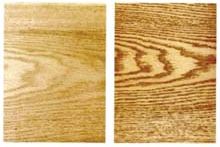
Staining and glazing
Depending on which wood species you use and the colors you want to achieve, a dye or a pigmented stain may be all the color you want in your finishes. In other cases, a dye may be used as the base color, which provides clarity and iridescence, followed by a sealer. Then a pigmented stain can be applied for added color enrichment to show off the wood's highlights and characteristics.
To take the two types of stains one step higher and to add further depth to the finish, follow this procedure:
After the stains have dried and they are sealed with a clear coat and allowed to dry again, apply a colored glaze and brush it out completely. If you thin out a colored glaze, it is referred to as a "wash." Wash color glazes can be very useful for changing the color of a finish, to "kick" one color over to another, or to darken the colors while still leaving clarity in the finish.
After you apply a wash color (or colors), brush it out and allow it to dry. Then you can start applying the final clear coats. This extra step adds color and radiance to the finish and beauty to your work. (See Photo Group C for examples of some color washes.)
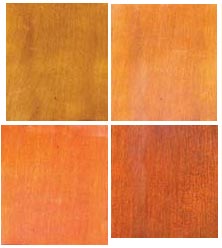
Glazing over toners and opaque-colored coatings
Most toners can be prepared with dyes or pigmented paste colorants. They can be transparent, translucent or opaque, depending on what type of finish is desired. I recommend you apply a clear coat to seal in the toners and opaque coatings, which will protect their colors from being changed by the additional applications of the colored glazes. This will give you clearer and cleaner finishes.
There are two techniques that can be used to apply glazes to sealed woods, stains, toners and opaque coatings. One is where the glaze is completely brushed out, leaving color and clarity to the finish. The second is when you bend your flat glazing brush and leave various fine or other size streak lines that simulate wood grains. These two brushing techniques also can be combined to create additional fine finishes. (Photo Group D shows samples featuring a maize-colored toner with a black brushed-out glaze.)
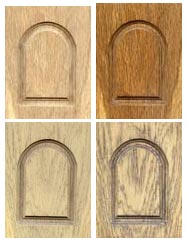
A few faux finishes
The illusions of faux finishes are created by manipulating color glazes. There are basically three steps to most faux finishes. One is the base color coat, which serves as the background color. Second is manipulating and working out colored glazes to create the faux illusions. Third is the application of clear coats to protect and preserve the finish.
Photo Group E shows some easy faux leather finishes. I often start with a red base coat, then apply and add a seal coat to preserve the red base color. I then take a black glaze and dab and mottle the entire surface to add some antiquing and create the faux leather effect. Next, I dampen a balled cloth with the mineral spirits I used as a solvent in the glaze, and I lightly mottle over the glaze. This technique softens the look and gives the faux finish a more natural appearance.
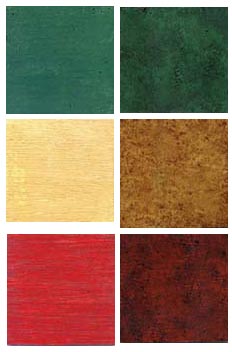
If you want a brown leather look, you can use tan, yellow, orange or a combination of those colors, depending on the background color you want. Then you can use a Van Dyke Brown or Burnt Umber glaze to do the leather antiquing, followed by the protective clear coats.
Another easy faux finish is a Verde Green faux marble. I start with a green base coat as the background, then use a black glaze to dab and mottle the entire surface. I again use the same type of solvent that is used to make up the glaze and dampen a balled cloth, and I lightly dab the damp cloth on the glaze to soften the effect of the faux green marble. I allow the glaze to dry and apply a clear coat to protect the finish. The difference between the marble and the leather faux finishes is determined by whether you leave the glaze with either a heavy or light mottled appearance in the final glazing.
As you become more familiar with using a colored glaze, you will find there are many ways to use these pigmented paste colorants. Colored glazes give finishers the ability to add or blend in colors, while still maintaining superb clarity in the finest finishes.
Pigmented mediums do not have to block out the wood's grains like paints do. If you get into a situation where you use pigmented stains, glazes, toners or shading stains and they have blocked out the wood's clarity, it is because the stains were not wiped dry, the glaze was not completely brushed out or the toner and shading stain was not thinned out for better translucency.
It may take some practice to perfect all of these glazing techniques. But it is worth your time and materials, since glazing is one of the most versatile and valuable finishing skills that you can master.
Mac Simmons is a freelance writer and 40-year veteran of the furniture finishing, refinishing and restoration trades. Questions may be directed to him in writing c/o CWB, 400 Knightsbridge Pkwy., Lincolnshire, IL 60069 or via e-mail c/o hkuhl@vancepublishing.com.
Reprinted with permission from Custom Woodworking Business.